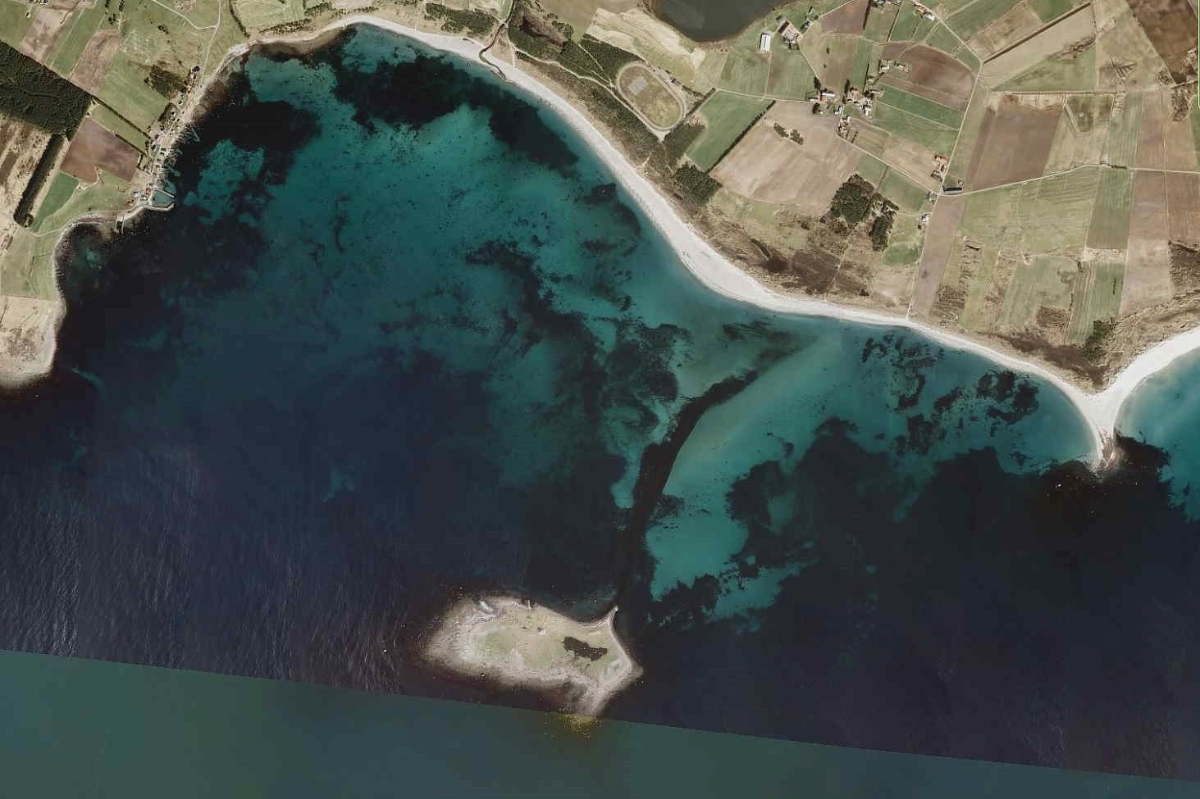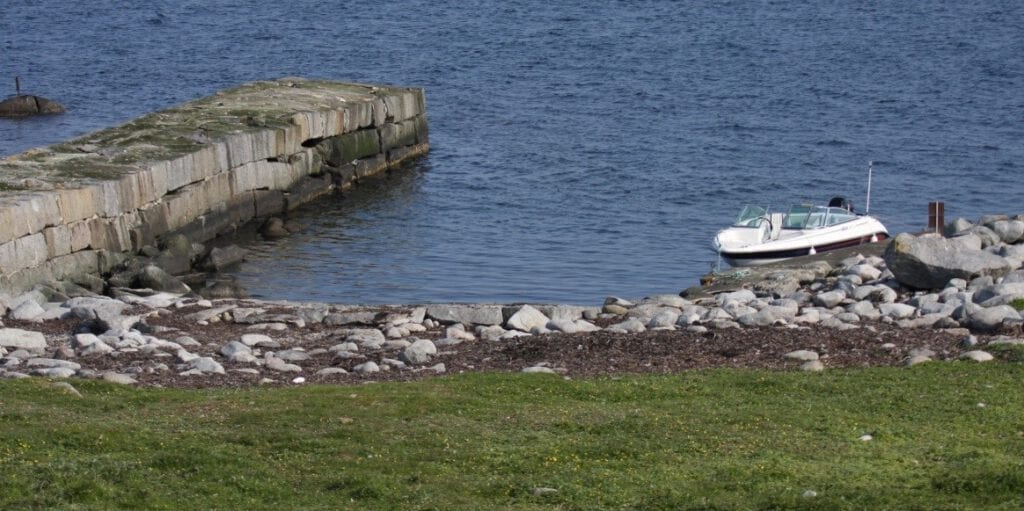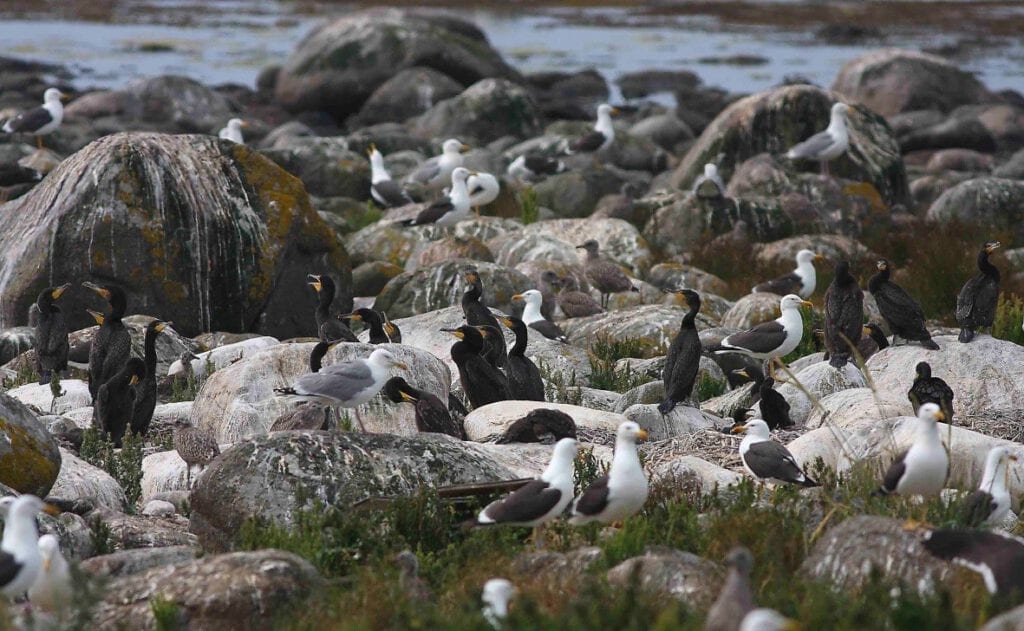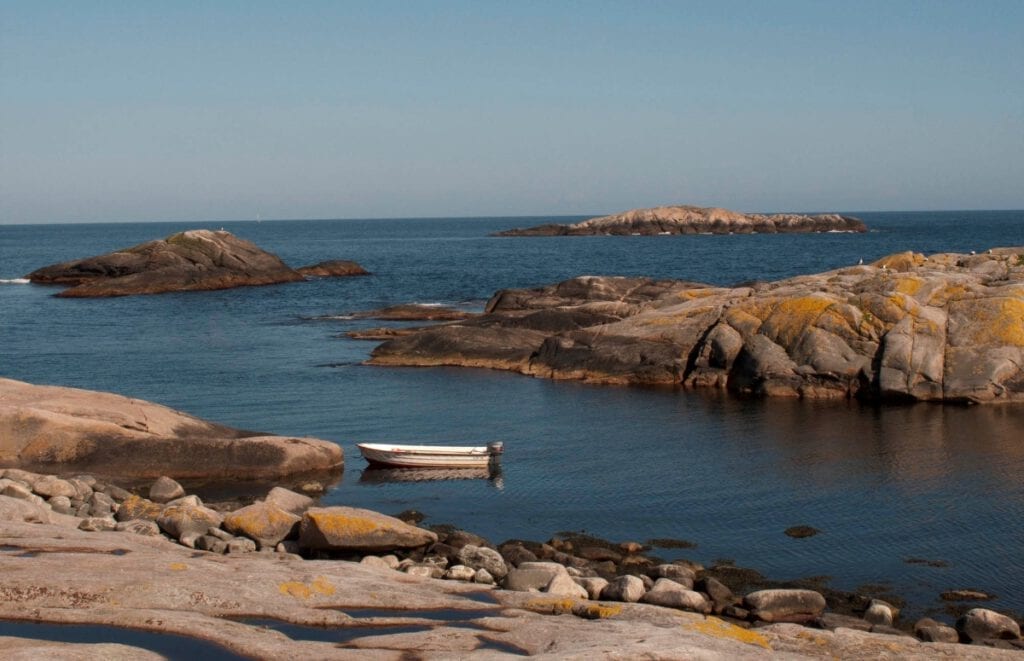Key site Agder
Key site Agder has the island Rauna in Farsund municipality as its main locality, but also comprises several sites in Mandal municipality. These are described separately below. Contact person: Børge Moe, NINA
Rauna
By south Norwegian standards, Rauna holds a large seabird colony and the island has been a SEAPOP key site since 2008. The breeding fraction of the seabird fauna is first and foremost dominated by gulls, but cormorants and ducks also breed in large numbers. Outside the breeding period, this locality is very important as a staging site for migrating waders, geese and ducks, while the seas around the island are important wintering habitats for coastal seabirds. Rauna was protected as a seabird reserve in 1980.
Location and description
Rauna (58° 33,5’ N, 6° 40’ E) is a small and low-lying island of boulders in Farsund municipality, Agder. It is a bit more than 1 km off the mainland and is the only island outside the Lista peninsula. The shallow sea area between Rauna and the mainland is included in the protected area along Listastrendene (the Lista beaches). The island and adjacent sea form a seabird reserve that covers an area of approximately 256 da, but only about 120 da are above mean high-water mark. Approximately 50 da are covered by vegetation (grass and herbs), while the rest consists of boulders. Rauna is part of the Lista moraine. There is a large burial site on the island with a beacon on top. The only other building on the island is a stone cabin, part of Østhassel rescue station, which was operated from 1872 to 1972. The small harbour on the island was also built during that period. The area is very exposed and, in stormy weather, the waves wash over large parts of the island.
Access
Rauna can only be reached by boat. The seas off Lista are very rough, and it may be very difficult to get ashore at Rauna, even in summer. The harbour is poor, and only small boats can be moored properly. Access to the island is generally prohibited from 15 April to 15 July, and no one is allowed to move closer than 50 m from the shore. This regulation does not apply to local landowners and property holders.
Wildlife
The fauna of breeding birds at Rauna included large colonies of the small gull species (black-headed gull Chroicocephalus ridibundus and common gull Larus canus), terns (arctic tern Sterna paradisaea, common tern S. hirundo and sandwich tern S. sandvicensis), several different waders, black guillemots Cepphus grylle and ducks. The large gulls were a minority in the 1970s. Between the protection of Rauna in 1980 and the turn of the millennium, however, the populations of large gulls and common eiders Somateria molissima grew continuously. The colonies of common gulls and terns collapsed in the late 1990s following many years of poor reproduction.
Since the turn of the millennium, greylag geese Anser anser, great cormorants Phalacrocorax carbo sinensis (the continental subspecies) and European shags P. aristotelis have all established as new, permanent breeding species at Rauna. Shelducks Tadorna tadorna, mallards Anas platyrhynchos and ringed plovers Charadrius hiaticula also breed annually.
Harbour seals Phoca vitulina and grey seals Halichoerus grypus can be seen at Rauna regurlarly, but they do not breed. Fortunately for the birds, mink Neovison vison have been absent since the 1990s.
Human activity
In addition to the activities generated by the rescue station and the lighthouse, people have hunted and collected eggs and driftwood at Rauna, and sheep have grazed on the island. The tradition of collecting driftwood contributed to exempting all landowners from the prohibition of access to Rauna in the breeding period, but this activity actually ceased long before that.
Up until the protection in 1980, egg harvesting was extensive and not viable as in e.g. North Norway. In practice, the nests were often plundered and all eggs of all species were collected, often late in the incubation period. The eggs were hardly ever eaten, and it is known that, among other things, they were used to fertilize the fields. The protection regulations do not allow egg collection and hunting on Rauna is prohibited until 1 October. After this date, geese, ducks and cormorants are hunted when it is possible to get ashore. It is particularly popular to hunt ducks and geese coming in for an overnight stop in the evenings. The large numbers of dabbling ducks and geese that often stay at Rauna in September therefore become scarce quite soon after 2 October.
There is a tradition to run sheep on Rauna, but the grazing has been limited in recent years. Despite this, the grazing pressure has increased substantially since 2000, seriously affecting the vegetation. Tall stands of grass, nettles and other herbs that previously covered large areas have now disappeared. Especially in years with long lasting dry spells in May and June, the vegetation at Rauna is completely eaten. Otherwise, in autumn, the vegetation is again grazed down, which is bad for the next growing season. The main problem is that there is very little cover left for chicks and nests, resulting in huge losses of eggs and young birds. Common eiders and lesser black-backed gulls Larus fuscus are hit particularly hard, and each year, hundreds of eider eggs and lesser black-backed gull chicks are eaten by great black-backs L. marinus, herring gulls L. argentatus and crows Corvus cornix.
Fieldwork
In the early 1970s, the work on seabirds at Rauna started with nest counts and ringing. From 1980 to 1987, populations were counted for the county governor usually by counting individuals and by ringing of gull chicks. From the 1988, Rauna was included in the The National monitoring programme for seabirds, and total nest counts have since been conducted. Rauna was one of the first sites where colour rings were put on gulls, starting in 1995. The breeding success of certain species has been assessed since 1988, while the registration of chick production of large gulls started after the millennium. Since being incorporated into SEAPOP in 2008, fieldwork at Rauna has been carried out by people connected to the Norwegian Ornithological Society.
Mandal
The SEAPOP sites in Mandal includes five islands, where four lie two and two. These were chosen as monitoring sites for two gull species because they have had a relatively stable population since the beginning of the 1980s, and are easy to access.
Location and description
The easternmost colonies in Mandal municipality are called Store and Lille Slettingen (57° 57’ N, 07° 29’ E). Further west we find Storøy (57° 59’ N, 07° 26’ E), and furthest west close to the border to Lindesnes municipality, we find Østre and Vestre Klovoholmene (58° 00’ N, 07° 20’ E). Slettingene and Klovholmene have been protected as nature reserves since 1980, while Storøy is not protected. The Slettingene islands are divided by a strait. They are approximately 700 m in extent, and cover 100 da. Storøy is 900 m from south to north, and covers an area of 26 da. None of the islands have been inhabited in recent times, so there are no buildings. All islands are quite far out in the archipelago and therefore affected by the coastal oceanographic climate of the southern coast of Norway. The Norwegian name of the island Slettingen describes the area’s topography well, where gneiss and migmatite are the dominating rocks. These are relatively acidic and nutrient-poor and resistant to weathering. Although rock outcrops limit vegetation, we still find quite a few herbs and heather on these islands. Sheep graze on Storøy. There are no trees at Slettingene, but on both Storøya and Klovhomen there are a few birch Betula pubescens, Sitka spruce Picea sitchensis and common juniper Juniperus communis.
Access
Slettingene, Storøy and Klovholmene are only accessible by boat, and it can be a bit rough around the islands. All have natural landing areas for smaller boats. Slettingene and Klovholmene are protected as nature reserves, and access to the islands prohibited from 15 April to 15 July.
Wildlife
Gulls dominate the birdlife on these islands, and the most abundant species is the southern subspecies of the lesser black-backed gull Larus fuscus intermedius. In addition to lesser black-backed gulls, the great black-backed gull L. marinus is monitored in the SEAPOP programme. Among other breeding bird species, we find common gull L. canus, greylag goose Anser anser, common eider Somateria molissima and Eurasian oystercatcher Hamentopus ostralegus. Vestre Klovholmen had in 1998 Vest-Agder’s first breeding pair of European shag Phalacrocorax aristotelis, but the species has probably not bred there since. Common shelducks Tadorna tadorna and mallards Anas platyrhynchos breed at Slettingen, and probably in some years also black guillemots Cepphus grylle.
All the islands on the southern coast of Norway can be reached by the American mink Neovison vison each year. However, it has only been reality on Store Slettingen since the monitoring begun in 2008. Slettningene is currently included in a programme for removal of mink organized by “Statens Naturoppsyn (SNO)”. You can regularly observe grey seal Halichoerus grypus and harbour seal Phoca vitulina at Slettingene, and harbour porpoise Phocoena phocoena can be seen at all localities. More unusual was a pod of killer whales Orcinus orca observed off Slettingene in May 2014. On Storøya and Klovholmene are European roe deer Capreolus capreolus. They have been seen eating gull eggs.

Photo: Morten Helberg
Human activity
There are relatively little human activity around these islands expect by professional and recreational fishers. This may affect the birdlife by the setting nets close to land. There is otherwise little or no egg harvesting, and only a limited hunt of seabirds in autumn. When the protection period ends on15 July, there is some disturbance from boat traffic, and this is unfortunate for some gulls, greylag geese, common eider and common shelduck, as their chicks have not yet fledged.
Fieldwork
Since the beginning of the 1980s, birds have been ringed on these islands, primarily gulls and terns. Ringing with colour-rings started in Mandal in 1997. Slettingene was included in the The national monitoring programme for seabirds in 1988, and since then all the nests on the two islands have been counted annually. As of 2008, Slettingene, Storøy and Klovholmene have been SEAPOP key sites in Agder for monitoring of herring gulls and lesser black-backed gulls.
Field work on the islands in Mandal is carried out by the Norwegian Ornithological Society, who register and/or ring birds for a few hours at a time. It is emphasized that the workers move carefully on the islands so that disturbance is kept to a minimum. Because it gets quite warm in midday, fieldwork is carried out during the morning and evening.







